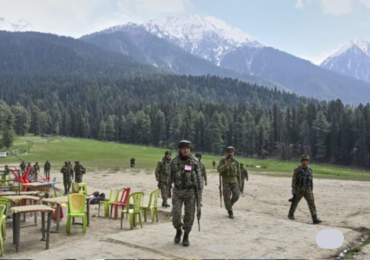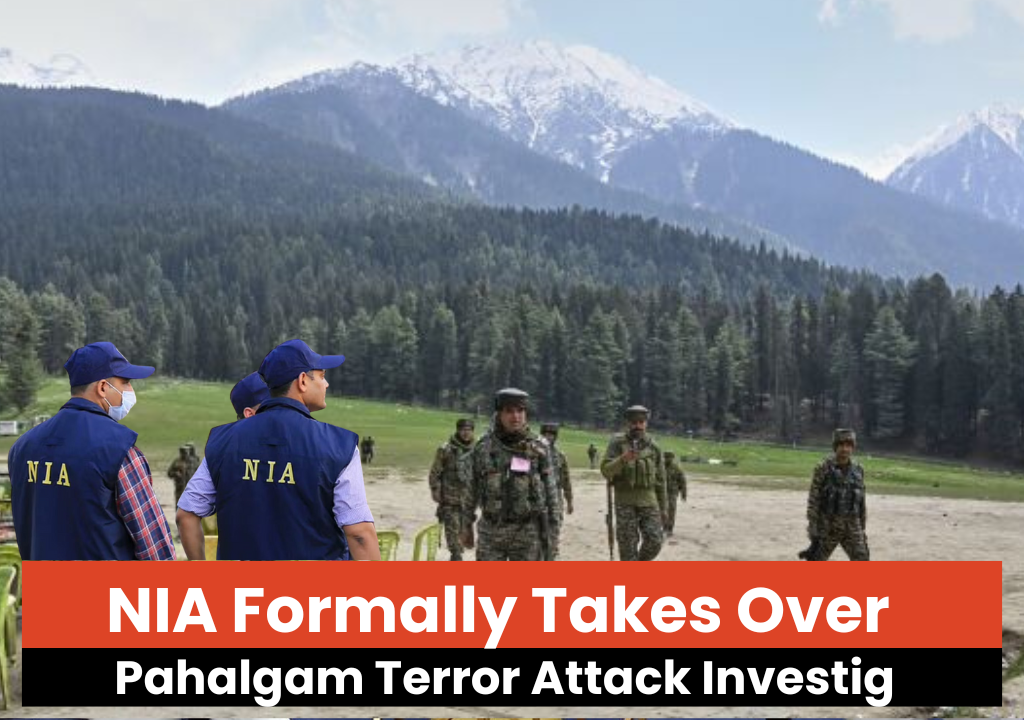Introduction
The NIA Pahalgam terror attack investigation has officially commenced, with the National Investigation Agency (NIA) taking over the case from the Jammu and Kashmir Police.
The April 22 attack in Baisaran meadow near Pahalgam, which claimed the lives of 26 tourists, has triggered one of the most intense anti-terror probes in the region in nearly two decades.
Given the gravity of the assault and its claimed orchestration by Pakistan-backed terror groups, the Ministry of Home Affairs directed the NIA to formally register a fresh FIR and lead the investigation.
NIA Formally Takes Over Pahalgam Terror Attack Investigation
On late Saturday, five days after the attack, the Counter Terrorism and Counter Radicalisation (CTCR) Division of the MHA issued an order handing the case to the NIA.
The NIA, India’s premier anti-terror agency, had already dispatched a team of investigators to Pahalgam shortly after the attack to assist the local police.
The attack, claimed by The Resistance Front (TRF) — a proxy of the banned Lashkar-e-Taiba (LeT) — left dozens injured and triggered a swift national and international response.
The formal takeover reflects the central government’s assessment of the incident as a cross-border orchestrated terror assault, requiring deeper forensic and intelligence-led investigation.
NIA Team Visits Attack Site and Meets Victims’ Families
The NIA team, led by a Deputy Inspector General (DIG)-rank officer, visited the Baisaran attack site on April 23 to:
- Collect forensic evidence
- Map the attack trajectory
- Identify critical eyewitness accounts
- Initiate a trauma support outreach with victims’ families
During these interactions, the NIA assured the families of a thorough and swift investigation aimed at bringing the perpetrators and their handlers to justice.
Evacuation operations for the injured, supported by helicopter services, were also coordinated immediately after the attack.

Focus on Lashkar-Linked Terror Network
Early findings point to the role of Pakistan-based terror groups, particularly Lashkar-e-Taiba and its proxy TRF, in planning and executing the attack.
Intelligence sources have highlighted that several of the attackers may have received training in Pakistan-occupied Kashmir (PoK) before infiltrating into Jammu and Kashmir.
In a significant development, authorities have identified five main terrorists involved in the attack:
- Three Pakistani nationals: Asif Fauji, Suleman Shah, Abu Talha (sketches released)
- Two local operatives: Adil Guri and Ahsan
A bounty of ₹20 lakh each has been announced for information leading to their capture.
Links Suggested: US Intelligence Chief Backs PM Modi’s Fight Against Pahalgam Terror Attack
List of Identified Active Local Terrorists
As the investigation deepens, security agencies have compiled a list of 14 local active terrorists providing ground-level logistical support to foreign operatives:
| Name | Affiliation | Active Since |
|---|---|---|
| Adil Rehman Dentoo | LeT (Sopore Commander) | 2021 |
| Asif Ahmed Sheikh | JeM (Awantipora Commander) | 2022 |
| Ahsan Ahmed Sheikh | LeT (Pulwama) | 2023 |
| Haris Nazir | LeT (Pulwama) | 2023 |
| Aamir Nazir Wani | JeM (Pulwama) | 2024 |
| Yawar Ahmed Bhat | JeM (Pulwama) | 2024 |
| Asif Ahmed Khanday | Hizbul Mujahideen (Shopian) | 2015 |
| Naseer Ahmed Wani | LeT (Shopian) | 2019 |
| Shahid Ahmed Kutay | LeT/TRF (Shopian) | 2023 |
| Aamir Ahmed Dar | LeT (Shopian) | 2023 |
| Adnan Safi Dar | LeT/TRF (Shopian) | 2024 |
| Zubair Ahmed Wani | Hizbul Mujahideen (Anantnag) | 2018 |
| Haroon Rashid Ganai | Hizbul Mujahideen (Anantnag) | 2018 |
| Zakir Ahmed Ganie | LeT (Kulgam) | 2020 |
The list forms part of a larger intelligence dossier being used to pre-empt future attacks and dismantle terror support infrastructure.
Links Suggested: FBI Director Kash Patel Condemns Pahalgam Terror Attack, Supports India
Ongoing Counterterrorism Operations
Following the NIA takeover:
- Massive cordon-and-search operations are underway in Pulwama, Anantnag, and Shopian districts.
- Agencies are specifically targeting terror safe houses, weapons dumps, and informant networks linked to the 14 listed terrorists.
- Drone surveillance and signal intelligence are being utilized to track cross-border communications.
Officials confirmed that coordinated action aims to capture or neutralize the terrorists and disrupt logistics chains aiding infiltration into Indian territory.
The immediate objective remains to cut off local support that enables attacks like the one in Pahalgam.
Conclusion
The NIA’s takeover of the Pahalgam terror attack investigation marks a decisive shift toward a centralized, intelligence-driven probe.
With clear evidence of Pakistan-backed terror involvement, India has escalated counterterrorism efforts across Kashmir.
The identification of key local operatives and the rapid launch of tactical operations signal that security agencies are leaving no stone unturned.
As the investigation progresses, the focus remains on ensuring accountability, preventing future attacks, and safeguarding the return of normalcy in Kashmir’s increasingly vibrant tourist season.
The nation — and the world — awaits swift justice for the victims of this heinous act.

